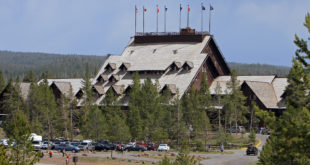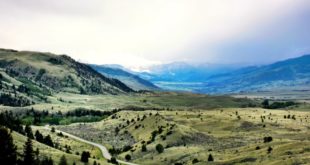[Monday, March 17, 2008] A non-profit organization, Trust for Public Land, has announced it will purchase for $8 million the last significant remaining privately owned land and mining claims of the “New World Mining District” and re-sell it to the U.S. Forest Service. This will bring closure to one of the hottest Yellowstone controversies of the 1990s.
The historic New World Mining District is located just north of Cooke City, Montana. As the raven roams, the area is less than four miles from the northeast boundary of Yellowstone National Park, and its water drainage flows into the park via Soda Butte Creek. Both of these facts worried conservationists and park officials, who saw a new mining operation in the area as a potential source of serious pollution for Yellowstone Park, and a major disruption for wildlife in the area.
Mining in the New World Mining District dates back to the 1870s with several periods of activity, but was considered to be played out by the 1930s. Then in 1989, Crowne Butte Mines, a subsidiary of the giant Canadian mining company Noranda, Inc., proposed a full-scale mining operation in the area. New mining technology and a booming metals market were said to make the mine profitable with a total value around $800 million. Plans for the “New World Mine” called for construction of a mining village for about 250 people in a valley above Cooke City, with the operation spread around several neighboring mountains, much of which was to be removed by the mining over a period of 10-15 years. The extracted rock, which contains relatively small amounts of gold, silver and copper, was to be chemically processed before shipping elsewhere for smelting. This processing entailed large water impoundments (dams with settling basins and tailing ponds), which environmentalists said were a risk in a region regularly affected by earthquakes.
The land for the mine consisted almost entirely of private property, about 2,600 acres in 130 patented mining claims. The detritus from decades of earlier mining – pits, mine shafts, miner’s shacks, rusting equipment, and small processing buildings – still dot the landscape. Because it was in private hands, the area was not included in the surrounding Absaroka-Beartooth Wilderness Area or Gallatin National Forest.
As expected, news of the proposed mine and the subsequent preparation for mining operations triggered a firestorm of controversy: For the Cooke City area and the state of Montana it pitted those who saw the mine as new money and jobs against those who championed the preservation of Yellowstone and its environment. This eventually led to neighbor versus neighbor hostility. Spreading much further, the mine controversy became a symbol for environmentalism that was picked up by the media world-wide. It also became an important part of the Clinton administration’s pro-environmental policy, which led to pitched battles between the Secretary of the Interior, Bruce Babbitt, and the mining industry.
The federal-state-industry confrontation reached its highest tension in 1995, when the Interior Department issued a temporary ban on mining in the area, the United Nations declared Yellowstone National Park an ‘endangered’ World Heritage Site, Congress threatened legislation to create a Yellowstone Headwaters Recreation Area, and Crowne Butte Mining was cited for environmental violations during its preliminary exploration and site-preparation.
In 1996 there was a breakthrough; a deal was struck by the U.S. government with Crowne Butte Mining Company and its partner Battle Mountain Gold—the mining plans would be abandoned in exchange for $65 million in federal land (or other assets, or cash), and the company’s agreement to spend $22.5 million on clean-up of existing pollution violations. This deal, “…Yellowstone is more precious than gold.” was announced August 12, 1996 by President Clinton at a ceremony held in the park in front of the dramatic backdrop of Barronette Peak a few miles from Cooke City.
Most people assumed this was the end of the story. Not quite. Crowne Butte Mining Company did not own the land or mining claims of the proposed mine; it leased them. The real owner was a retired Cooke City school teacher, Mrs. Margaret Reeb.
Mrs. Reeb, the daughter of a Cooke City mine manager, was born and raised in the area and having both an interest in mining and an instinct for business, managed over the years to purchase nearly 8,000 mining claims in the New World Mining District. In what is tempting to call a typical snafu, Mrs. Reeb was not included in the negotiations. Although the mining companies could walk away with their deal (taking their money and disgust with environmental regulation to South America); Mrs. Reeb insisted on honoring the mining tradition of the area and refused to sell her claims, which left the door open to future mining projects.
More jockeying ensued, with the government making it clear that one way or another, mining was not going to happen in the area. Mrs. Reeb eventually agreed not to mine the land, but she continued ownership until her death in 2005.
By 2005 something else was happening to the area around Cooke City. As one of the limited number of areas with private land near Yellowstone Park; it was feared that Mrs. Reeb’s land might be a target for commercial recreation and housing developers. Because of the wilderness character of the entire area and its importance to the wildlife ecosystem of Yellowstone Park, the spread of Mc Mansion Chalets and log-cabin subdivisions is considered in some ways even more inimical than mining. It would certainly be more long-lasting.
To head off this possibility, the Trust for Public Land began negotiations with Mrs. Reeb’s heirs, nephews Mike and Randy Holland, which led to the recent announcement that for $8 million, delivered over two years, the Trust would purchase the land and mining claims, and resell to the government, which would then incorporate the area into the Gallatin National Forest. End of mining story, for a while at least.
 Yellowstone Insider Your Complete Guide to America's First National Park
Yellowstone Insider Your Complete Guide to America's First National Park





